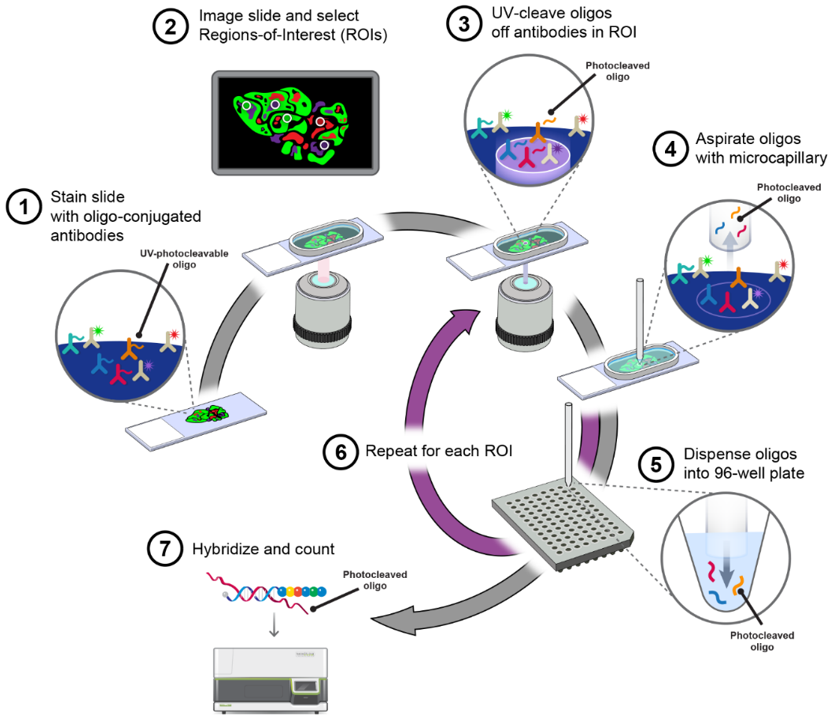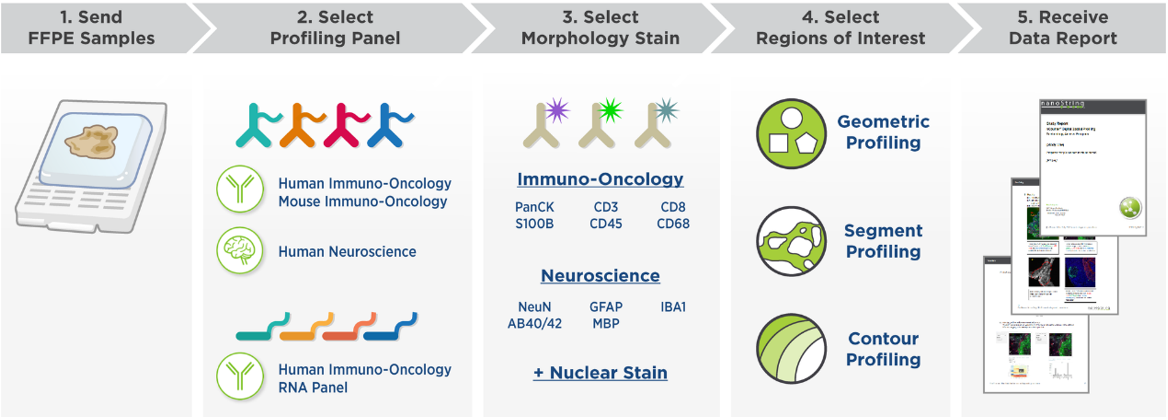Digital Spatial Profiling
Digital Spatial Profiling (DSP) is a nondestructive method for high-plex spatial profiling of proteins and RNA from a wide variety of sample types, including formalin-fixed, paraffin-embedded (FFPE) tissue sections. This method uses small photocleavable oligonucleotide "barcodes" covalently attached to in-situ affinity reagents (antibodies and RNA-probes) to provide unlimited multiplexing capability. Spatial Profiling is useful for examining cellular interactions, tissue heterogeneity, pathogenicity, and response to therapy.
In the ear of immune-oncology. It is critical to unravel mechanism of action underlying sensitivity or resistance to current immunotherapies in order to identify predictive biomarkers of response and then discover novel actionable therapeutic targets. The Nanostring GeoMx Digital Spatial Profiling platform enables the measurement of patterns of gene expression in specific targeted areas of interest on tumor sections to identify gene or pathway activation differences that may provide information on potential diagnostic markers or pathway activation differences that may provide information on potential diagnostic markers or therapeutic targets.
Start from specimens as simple as FFPE tissue samples, this novel technology offers through selected panels the simultaneous analysis of up to 96 mRNAs or 10-100 proteins in several regions of interest (ROIs) divided in two compartments.
Full Service Workflow


Highlights
- Non-invasive approach preserving sample integrity
- Highly multiplexed RNA or protein detection- up to 1800 targets in a run from a single FFPE section
- Whole slide imaging with up to 4 fluorescent channels to capture tissue morphology and select regions of interest (ROI) for high-plex profiling
- Possible multianalyte analysis for deep sample characterization
- Digital quantitation with integrated data normalization and analysis
Applications
- Investigate heterogeneity and microenvironments of tumors
- Identify genes associated with lymphocyte tumor infiltration
- Characterize markers of immune response
- Profile normal and diseased tissue in the same sample
- Compare pluripotent and differentiated cells
- Characterize disease pathology
- Monitor therapeutic response
Quotation and ordering
Call us today or email us for a quotation or if any questions! Our customer service representatives are available 24hr a day! We thank you for choosing Creative Bioarray at your preferred Digital Spatial Profiling (DSP).
For research use only. Not for any other purpose.
Services
-
Cell Services
- Cell Line Authentication
- Cell Surface Marker Validation Service
-
Cell Line Testing and Assays
- Drug-Resistant Cell Models
- Cell Viability Assays
- Cell Proliferation Assays
- Cell Migration Assays
- Soft Agar Colony Formation Assay Service
- SRB Assay
- Cell Apoptosis Assays
- Cell Cycle Assays
- Cell Angiogenesis Assays
- DNA/RNA Extraction
- Custom Cell & Tissue Lysate Service
- Cellular Phosphorylation Assays
- Stability Testing
- Sterility Testing
- Endotoxin Detection and Removal
- Phagocytosis Assays
- Cell-Based Screening and Profiling Services
- 3D-Based Services
- Custom Cell Services
- Cell-based LNP Evaluation
-
Stem Cell Research
- iPSC Generation
- iPSC Characterization
-
iPSC Differentiation
- Neural Stem Cells Differentiation Service from iPSC
- Astrocyte Differentiation Service from iPSC
- Retinal Pigment Epithelium (RPE) Differentiation Service from iPSC
- Cardiomyocyte Differentiation Service from iPSC
- T Cell, NK Cell Differentiation Service from iPSC
- Hepatocyte Differentiation Service from iPSC
- Beta Cell Differentiation Service from iPSC
- Brain Organoid Differentiation Service from iPSC
- Cardiac Organoid Differentiation Service from iPSC
- Kidney Organoid Differentiation Service from iPSC
- GABAnergic Neuron Differentiation Service from iPSC
- Undifferentiated iPSC Detection
- iPSC Gene Editing
- iPSC Expanding Service
- MSC Services
- Stem Cell Assay Development and Screening
- Cell Immortalization
-
ISH/FISH Services
- In Situ Hybridization (ISH) and RNAscope Services
- Fluorescent In Situ Hybridization
- FISH Probe Design, Synthesis and Testing Service
-
FISH Applications
- Multicolor FISH (M-FISH) Analysis
- Chromosome Analysis of ES and iPS Cells
- RNA FISH in Plant Service
- Mouse Model and PDX Analysis (FISH)
- Cell Transplantation Analysis (FISH)
- In Situ Detection of CAR-T Cells & Oncolytic Viruses
- CAR-T/CAR-NK Target Assessment Service (ISH)
- ImmunoFISH Analysis (FISH+IHC)
- Splice Variant Analysis (FISH)
- Telomere Length Analysis (Q-FISH)
- Telomere Length Analysis (qPCR assay)
- FISH Analysis of Microorganisms
- Neoplasms FISH Analysis
- CARD-FISH for Environmental Microorganisms (FISH)
- FISH Quality Control Services
- QuantiGene Plex Assay
- Circulating Tumor Cell (CTC) FISH
- mtRNA Analysis (FISH)
- In Situ Detection of Chemokines/Cytokines
- In Situ Detection of Virus
- Transgene Mapping (FISH)
- Transgene Mapping (Locus Amplification & Sequencing)
- Stable Cell Line Genetic Stability Testing
- Genetic Stability Testing (Locus Amplification & Sequencing + ddPCR)
- Clonality Analysis Service (FISH)
- Karyotyping (G-banded) Service
- Animal Chromosome Analysis (G-banded) Service
- I-FISH Service
- Molecular Karyotyping (aCGH)
- Droplet Digital PCR (ddPCR) Service
- Digital ISH Image Quantification and Statistical Analysis
- SCE (Sister Chromatid Exchange) Analysis
- Biosample Services
- Histology Services
- Exosome Research Services
- Drug Metabolism and Pharmacokinetics (DMPK)
-
Safety Evaluation Services
- High-Content Cytotoxicity Screening
- High-Throughput Toxicity Screening
- In Vitro Cardiotoxicity
- In Vitro Genotoxicity
- In Vitro Hepatotoxicity
- In Vitro Neurotoxicity
- In Vitro Nephrotoxicity
- In Vitro Dermal Toxicology
- Ocular Toxicity
- In Vitro Cytotoxicity
- Endocrine Disruption Screening Assay
- In Vivo Toxicity Study